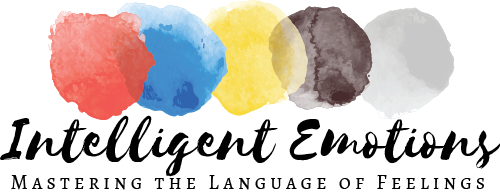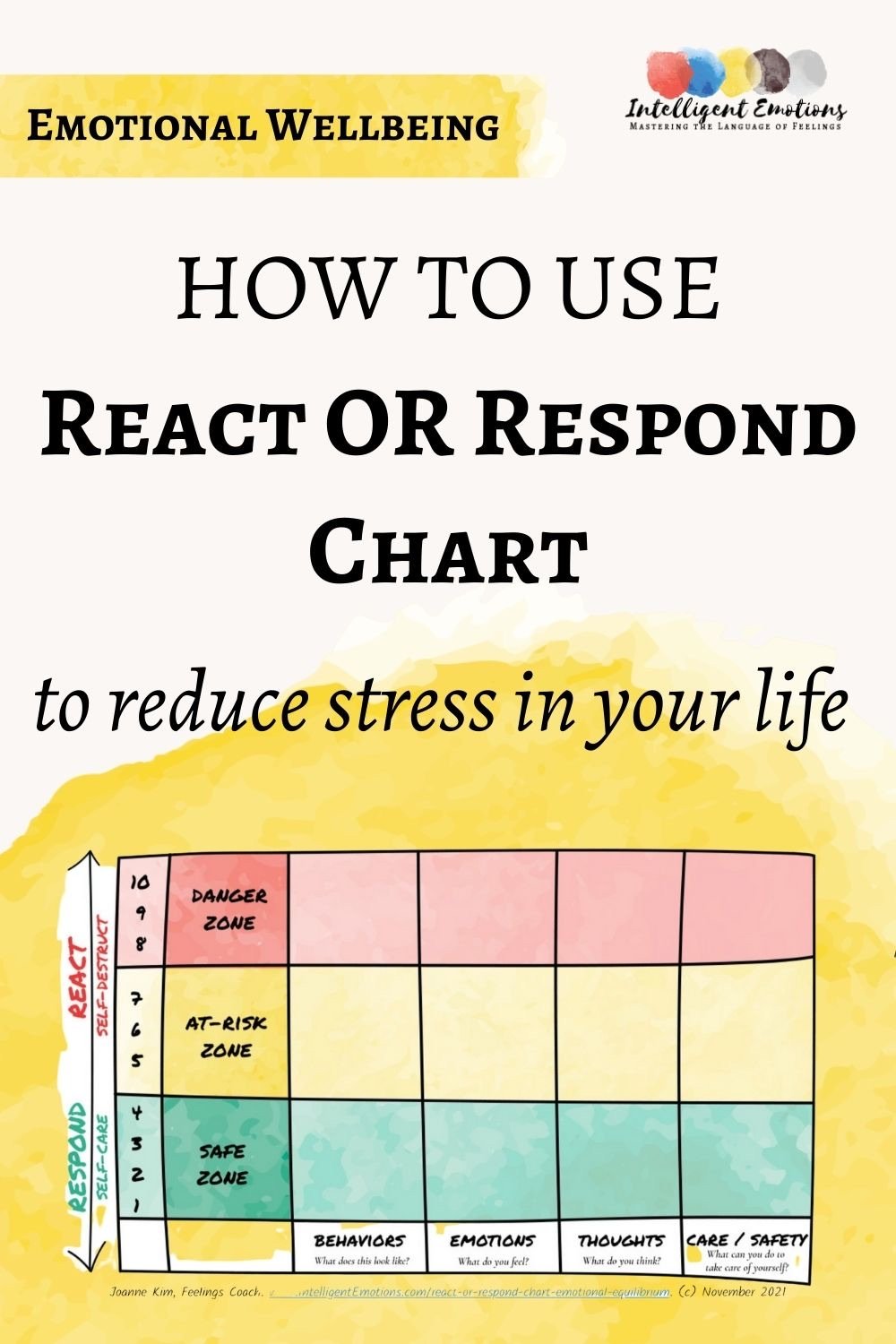Reducing Stress With a React or Respond Chart
Have you ever heard about the React or Respond Chart and how you can use it to reduce stress and protect your emotional equilibrium? No? Read on.
Autopiloting in Stress
Think about the most recent time you reacted in ways that made things worse.
You got chewed out by your boss at work, came back home agitated, and kicked the dog who bit you back.
You feel overwhelmed and anxious about that big project, yet you find yourself putting it off and beating yourself up about it.
Even though you feel lonely, you have a hard time reaching out to others because you don’t want to burden anyone. So you Netflix binge to numb your feelings, to feel even worse afterward.
Sound familiar?
When our stress levels get past a certain point, the prefrontal cortex (the part of our brain behind our forehead that makes wise, sound decisions to help us function in life) actually shuts down. In this space, we are more likely to make reactive decisions that often make things worse, not better. Best intentions won’t play out the way we want until we can soothe our nervous system, reduce our stress levels, and turn the prefrontal cortex/thinking brain back online.
When we’re NOT aware of how we’re doing, we are likely to react and self-destruct because our stress compounds. When we ARE aware of how we’re doing, we’re more equipped to respond and do self-care that actually reduces stress. Writing out our usual dynamics on paper usually makes it easier for us to notice these patterns in the future, giving us a chance to shift out of reactive habits that usually get us into trouble.
When we are in different states of stress, we tend to exhibit familiar patterns of thinking, feeling, and doing. Sometimes we might not realize how stressed we are until we see some of these signs.
Prepare for war during times of peace, not times of war!
Plan ahead what you can do to take care of yourself while your prefrontal cortex is active, because when stress levels strike, you’re not going to be able to do that effectively.
The React vs Respond Chart is a tool to learn more about your autopilot habits and to preplan some self-care steps. Consider this a cheat sheet for you to refer to when you notice you’re becoming more stressed.
Using the React or Respond Chart to Reduce Your Stress
If I were a fly on the wall observing you in your natural habitat, what I would see you doing?
How would I be able to tell how stressed or relaxed you are?
In this React or Respond Chart, there are three rows (Safe Zone, At-Risk Zone, Danger Zone) and four columns (Behaviors, Emotions, Cognitions, and Self-care/Safety Plan).
The numbers on the left indicate your stress level on a scale of 1 (low stress) to 10 (high stress). Each row describes what you tend to do (Behaviors), feel (Emotions), and think (Cognitions), along with some ways you can take care of yourself (Self-care/Safety Plan) to reduce your stress levels in the corresponding stress “zone” you’re in.
Safe Zone (stress level 1-4) - when you’re the most relaxed, grounded, rested, and energized
At-Risk Zone (stress level 5-7) - when you’re doing well enough to function, but if a few more stressful things happen, it may knock you off balance and tip you over into the red
Danger Zone (stress level 8-10) - when you’re really not doing well and you’re having strong reactions that make things worse for yourself and/or others
Fill this chart in from the bottom up (Safe Zone to Danger Zone) through each of these dimensions of yourself:
Behaviors - What might a fly on the wall see you doing?
Emotions - What do you tend to feel? (Think the Big 5 Emotions - MAD, SAD, GLAD, SCARED, NUMB, if you need a starting point)
Cognitions - What do you tend to think about yourself? Others? Life? The world?
Self-care/Safety Plan - What are some activities or exercises you can do to reduce your stress and help you soothe?
*It’s TOTALLY okay if you are having a hard time completing this chart. You might ask someone who knows you well and with whom you feel comfortable to fill this out with you.
Here are some examples:
Safe Zone (stress levels 1-4)
Behaviors - socializing a lot, singing while doing chores, playing music, yoga, hammocking
Emotions - peaceful, excited, energized
Cognitions - I am safe, I know how to do this, others care about me
Self-care/Safety Plan (what you do to keep you in the green) - calling a friend to let them know how I’m doing, eating healthily, reading books, finding a hobby, meeting with a therapist or life coach routinely to continuously grow
At-Risk Zone (Stress levels 5-7)
Behaviors - keeping to myself, spending more time alone, snapping at others, Netflix binging, tunnel visioned, taking things personally, overworking
Emotions - tense, irritable, overwhelmed, rushed
Cognitions - Why do I always have to do things by myself? Others can’t be trusted, or I don’t know how to do this.
Self-care/Safety Plan (what you do to get you back down to the green) - taking a vacation, asking others for help, delegating tasks, working out, putting limits on what to focus on, not starting new projects, meeting with a therapist to learn self-care and stress management skills
Danger Zone (Stress levels 8-10)
Behaviors - drinking to numb out, trouble sleeping (too much/too little/inconsistent), isolating and not talking to anyone, not going to work, stuck in bed for days at a time, causing fights with loved ones
Emotions - shut down, rage, depressed, hopeless
Cognitions - I hate myself, I hate life, No one’s going to miss me anyway, Things will always be like this, I can never get anything right
Self-care/Safety Plan (how to reduce stress ASAP) - schedule an appointment with a doctor or therapist, call someone you feel most safe with, and ask for help in deciding what you need to do next
Reducing Stress: Self-Care & Safety Plan
Whereas the first three columns of Behaviors, Emotions, and Thoughts are what you naturally tend to do without trying, the last column of Self-care/Safety Plan involves things that you would do on purpose to protect your emotional balance. This is where you can identify hobbies or things you gravitate to, such as doing jigsaw puzzles, gardening, playing music, or reaching out to a friend. Self-care is a little different from behavior in that this is meant to keep you in the safe zone (grounded and more energized).
Often, when stress levels tend to rise, our hobbies are usually the first things to go, even though they’re precisely what we need SO THAT we can keep our stress levels low. Make sure the activities listed in this box are very simple, concrete, easy things that you can do or start doing within 3 minutes. The more abstract or less defined these activities are, the less likely you’ll actually do them when you need to.
If you’re feeling stuck on this part, talk to a friend or a therapist who can help come up with ideas of things you can realistically do.
When you’ve filled out the chart, make 2-3 copies. Post one copy where you see it often (e.g., the fridge, on your work desk, on your nightstand) and give a copy to someone who can refer to this to care for you well (e.g., partner, close friend, family member, therapist).
What’s Your Baseline Stress Level?
Based on what you’ve written in your React or Respond Chart, on the 10-point stress scale, what seems to be your baseline stress level nowadays? Do you find yourself hovering around a 6 or 7, teetering the edge of the Danger Zone? Or close to a 4 or 5 where you can readily scoot down into Safe Zone?
Circle that baseline number, and set an intention of lowering that set point over the course of the next month, either with the help of a loved one, self-development books or podcasts, or therapy.
The BIG Feelings First Aid Kit
Messy feelings spilling out at the WRONG TIME, WRONG PLACE, WRONG WAY?
Grab this free PDF guide that shows you how to handle feelings like a pro so that you can keep moving forward in life!
Save this chart to use it later!
Other Blogs on Emotions
© Copyright 2023 Joanne Kim. All rights reserved.
Joanne Kim, Feelings Translator
Hi! I’m a therapist-turned feelings coach who helps Highly Sensitive Persons, Empaths, Enneagram 2s & 4s, etc. turn their BIGGEST feelings into their GREATEST superpower!
They are often the first (or only) person in their family to intuitively process and express feelings; consequently, they are often judged or criticized so that they learn to people please, placate, or perform until they hit a wall.
They’re super familiar with anxiety, guilt, and shame, partly because of an allergic reaction to anger (theirs and others').
Often the super responsible, empathic, and ethical person in their environments, they reach out to me after they're already burned out, resentful in their relationships, or sucked into their shame spiral.
The most common feedback I get from people when I share about how feelings work is,
"Why didn't anyone teach me this in school??"
Hence, I am building a school helping people work WITH their feelings so their feelings work FOR them.










Perhaps there’s a better North Star to follow than The Pursuit of Happiness! Learn more about Emodiversity, the top indicator of wellness that speaks to the breadth & depth of emotions that you experience!